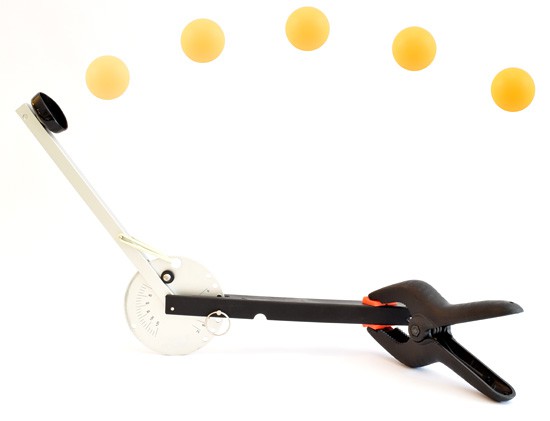Ping Pong Catapult
Summary
Overview
Learn about potential and kinetic energy the fun way—by launching ping pong balls across the classroom with a catapult!Learning Objectives
- Understand what kinetic and potential energy are, and how one can be converted to the other.
- Design and conduct an experiment to measure how changing one variable affects another.
NGSS Alignment
This lesson helps students prepare for these Next Generation Science Standards Performance Expectations:- MS-PS3-5. Construct, use, and present arguments to support the claim that when the kinetic energy of an object changes, energy is transferred to or from the object.
|
Science & Engineering Practices
Planning and Carrying Out Investigations.
Plan an investigation individually and collaboratively, and in the design: identify independent and dependent variables and controls, what tools are needed to do the gathering, how measurements will be recorded, and how many data are needed to support a claim.
Analyzing and Interpreting Data Construct and interpret graphical displays of data to identify linear and nonlinear relationships. |
Disciplinary Core Ideas
PS3.A: Definitions of Energy.
Motion energy is properly called kinetic energy; it is proportional to the mass of the moving object and grows with the square of its speed.
A system of objects may also contain stored (potential) energy, depending on their relative positions. PS3.B: Conservation of Energy and Energy Transfer. When the motion of an object changes, there is inevitably some other change in energy at the same time. |
Crosscutting Concepts
Energy and Matter.
Energy may take different forms (e.g. energy in fields, thermal energy, energy of motion).
The transfer of energy can be tracked as energy flows through a designed or natural system. |
Materials
 Image Credit: Ben Finio, Science Buddies / Science Buddies
Image Credit: Ben Finio, Science Buddies / Science Buddies
- Ping Pong Catapult Kit, available from our partner Home Science Tools (also available as a Classroom Kit specially priced for teachers)
- Tape measure (preferably metric) or several meter sticks
- Rubber bands (one for each student)
Disclaimer: Science Buddies participates in affiliate programs with Home Science Tools, Amazon.com, Carolina Biological, and Jameco Electronics. Proceeds from the affiliate programs help support Science Buddies, a 501(c)(3) public charity, and keep our resources free for everyone. Our top priority is student learning. If you have any comments (positive or negative) related to purchases you've made for science projects from recommendations on our site, please let us know. Write to us at scibuddy@sciencebuddies.org.
Background Information for Teachers
This section contains a quick review for teachers of the science and concepts covered in this lesson.The ping pong catapult is powered by rubber bands. When you pull back the arm of the catapult, you stretch the rubber bands, and they store potential energy. There are different types of potential energy. Many middle and high school science textbooks first deal with gravitational potential energy, or the amount of potential energy something has based on its mass and height above the ground. However, in this case you are dealing with elastic potential energy, or the potential energy materials have when stretched, bent, or compressed. The more you stretch the rubber bands, the more elastic potential energy they store.
When you release the catapult's arm, the rubber bands contract, and their potential energy is converted to kinetic energy, or the energy of motion, of the ping pong ball, which flies through the air. An object's kinetic energy depends on its mass (how heavy it is) and its velocity (how fast it is going). If two objects are moving at the same speed, the heavier one will have more kinetic energy. If two objects have the same mass but are moving at different speeds, the faster one will have more kinetic energy. Note that the ping pong ball also has gravitational potential energy depending on its height off the ground.
Conservation of energy states that energy cannot be created or destroyed; it can only change from one form to another. In this case, most (but not all) of the elastic potential energy from the rubber bands is converted to kinetic energy and gravitational potential energy of the ball. Some of the potential energy is converted to heat energy because of friction. Even though it is commonly said that this energy is "lost," it is important to remember that it has not actually vanished—it has just changed from one form to another.
The key question your students will investigate in this activity revolves around energy changing from one form to another. What happens if you stretch the rubber bands farther initially? That means they store more potential energy, and due to conservation of energy, the ping pong ball will have more kinetic energy when it launches (since its initial height will always be the same, its initial amount of gravitational potential energy will not change). Since the ball's mass remains constant, that means it will be going faster, and it should fly farther. But, do not give that answer away to your students—let them figure out an experiment to measure it!






